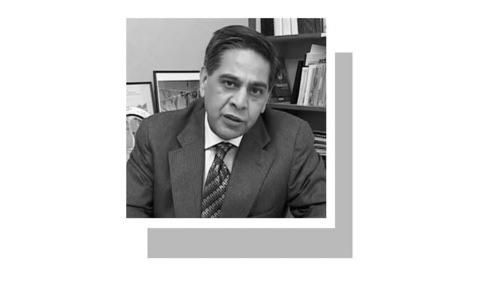
THE struggle that started on March 23, 1940, reached its zenith on August 14, 1947. The journey represented the expression of the commitment to get to a target, and then the ultimate success in achieving that target.
Over the years, understanding the dynamics behind the 1947 partition has whetted the appetite of scholars and historians for unearthing the truth about speculations and myths about the narrative of how the subcontinent was divided.
The analysis of the British divide-and-rule policy has received fair attention from post-partition historians. It sparked intense debate over the role of the colonial rulers in disintegrating British India. It has generated controversies surrounding whether the partition of India was a planned affair or a result of a change triggered by geopolitical and historical factors.
However, it can be argued that in both cases, the role of leadership was a crucial factor in the making of Pakistan.
The outline that the Lahore Resolution had drawn in the shape of geographical zones and majority areas got a concrete shape later on because the Quaid was able to see an opportunity and moved swiftly to make the most of it.
Some historians believe that the partition of India was inevitable even though the British adopted the policy of keeping India united. K.B. Sayeed has explained the background to Pakistan Movement by mentioning that Quaid-i-Azam Mohammad Ali Jinnah indicated in his interview with Beverley Nichols that the idea of the partition of India had first occurred to John Bright some two decades after the 1857 War of Independence. It was evident from the way the partition plan was manipulated, mainly due to bitter opposition from Congress, that the initial idea was to transfer power to several successor states.
The analysis of K.B. Sayeed suggests that the idea of a separate homeland for Muslims was floated in 1883. Wilfrid Scawen stated plainly that Northern India’s provinces were to be administered by the Muslims and Southern India by the Hindus. Under this scheme, the British were to maintain their overall control. However, they intended to give provinces some powers to handle finance and administration.
The Government of India Act, 1919, made it evident that the British intended to devolve power to the indigenous peoples. As a result, Muslims began to make a concerted effort to obtain a share of authority.
In 1924, the Muslims demanded reforms in the North-West Frontier Province in an All-India Muslim League (AIML) session. A group of seven parliamentarians, led by Sir John Simon, visited India in 1927 to explore the possibilities of reforming the constitution and studying the working of the Government of India Act, 1919. The group retained the separate status of Muslims.
In 1928, the Nehru Report also noted Muslim apprehensions about their separate interests. The Quaid-i-Azam responded to the report through his famous Fourteen Points, which put the table a viable strategy to save and protect the distinct identity of Muslims as a separate community and to protect their legitimate rights.
Allama Iqbal further conceptualised the aspirations of Muslim in his 1930 Allahabad address. Five years later, the 1919 Act was replaced by the 1935 Act, which introduced a federal form of government, as mentioned in Jinnah’s Fourteen Points, and incorporated some Muslim demands, including Sind’s separation from the Bombay Presidency.
However, the 1935 Act was unable to safeguard all the legitimate interests of Muslims. In 1938, the League gave all powers to its president to work out an alternative strategy to deal with the Act.
Moreover, anti-Muslim policies during the Congress rule from 1937 to 1939 also exposed its failure to accommodate Muslim interests. In 1938, resolutions passed at the Sindh Muslim League Conference held in Karachi expressed the disapproval of the notion of ‘federation’ enshrined in the 1935 Act.
While all this was going on in the subcontinent, new realities emerged elsewhere, as Germany and Britain declared war on each other in September 1939. That year, the Central Legislature passed the Defence of India Act, authorising emergency powers and supporting the British effort related to the Second World War. This created an opportunity for the Congress and the League leadership to engage with the British in political bargaining.
On September 18, Quaid-i-Azam, through the Muslim League’s working committee, unequivocally stated that Muslims would lend their support on the condition that they were assured that future constitutional reforms and a new constitution would not be framed or adopted without the League’s consent.
As the War raged on, it was clear that the British would no longer continue their rule over the subcontinent because the colonial authority had been shrinking owing to security threats. This further increased the bargaining position of Indian leaders across the political spectrum to negotiate with the British.
Despite Lord Linlithgow’s assurance of granting the dominion status to India and bringing constitutional changes in the light of Indian views, Congress was using various tactics to put pressure on the British to transfer power to it sooner or later.
In March 1940, Congress adopted a resolution condemning the War, describing it as a means to reach “imperialist ends”, and made itself clearly disassociated. The Congress wanted to make the most of the precarious situation faced by the British. It rejected the dominion status by arguing that Indian freedom “cannot exist within the orbit of imperialism” and sought to take over charge as the sole successor to the British.
The Quaid-i-Azam, already aware of Congress’s intentions and its political manoeuvrings, proclaimed that before any constitutional settlement, it must be recognised that India was not one nation but two and that the Muslims would not accept arbitration of anybody, be it Indian or British, but would determine their destiny by themselves.
Jinnah’s thoughts took practical shape in the form of the Lahore Resolution, which came as a clear response to the legitimacy claimed by Congress under its self-generated image of being the only representative party of the Indian people. The landmark resolution was passed on March 23, 1940, at Minto Park – subsequently renamed the Iqbal Park – near the Lahore Fort by the All-India Muslim League to represent the aspirations of the entire Muslim community of the subcontinent.
Thus, Pakistan was established as a result of the Two Nation Theory, which codified the rights of Muslims in British India. The Lahore Resolution provided a constitutional blueprint, outlining the features of a federation, independence and the creation of autonomous and strategically viable units constituted in such geographical locations where Muslims were in the majority.
The formation of these units in the North-Western and Eastern zones of colonial India was based on demographic, historical and cultural factors. This idea received polarity of views and opinions expressed by various leaders.
H.V. Hodson believed that the resolution was a “broad aspiration to which it was politically easier to adhere to in principle” than to execute it on the ground.
The Hindu press, however, translated this resolution as the ‘Pakistan Resolution’. It was declared as a ‘mad scheme’ by Jawaharlal Nehru and described by Viceroy Linlithgow as Jinnah’s political manoeuvring.
Originally, the resolution did not mention the word ‘Pakistan’ and it talked about ‘states’, but this ambiguity and vagueness were later made clear by the League at a convention in Delhi on April 19, 1946, and subsequently the criticism by the Hindus was responded to in an effective manner.
Meanwhile, in 1941, the third year of World War II, Japan advanced in the United States by attacking the naval base at the Pearl Harbour, and also conquered Singapore. Britain’s failure to protect Burma and Malaya created a reason to be worried about India’s vulnerability. Japan’s war propaganda was also aimed at encouraging the Indians to initiate a revolt against the British, but the situation largely remained calm, mainly because political parties remained engaged by the British.
However, the British government was under constant pressure from its allies, including the then US president Franklin Roosevelt, to resolve the Indian problem. Besides, Winston Churchill, the then prime minister of the united Kingdom, was also convinced by Sir Stafford Cripps, a member of his War Cabinet, to negotiate a realistic solution to the Indian problem.
In February 1946, after the War was over, the British parliament decided to send three cabinet ministers to India, including Lord Pethick-Lawrence, Sir Stafford Cripps and A.V. Alexander. They arrived in India to develop a consensus for seeking the broadest measure of agreement on constitutional conventions and procedures of a future constitutional framework and establishing a new executive council.
According to H.V. Hodson, the British cabinet members neither had the authority to hammer out their own solutions nor were they empowered to suggest their own proposals. They just came to engage the Indian leadership into a political dialogue for framing a future constitution by themselves. They were here to resolve the issue of constitution-making and convince the leadership of major political parties to make this possible.
However, the way they conducted themselves during the negotiations showed their inadequacy. After failing to achieve an agreement on their plan, they alternatively put forward their own proposals in May 1946.
Apparently, the plan brought back the same concept of the Cripps Mission of 1942, which had been thwarted by Indian political leaders. These proposals contemplated a constitution with a weak Centre dealing with few subjects, including foreign affairs, defence and communications.
Jinnah, being a consummate statesman and a wise leader, had a special knack for understanding situations and foreseeing possible scenarios. Thus, he was able to see the shortcomings of the Cabinet Mission Plan. But, more importantly, he was able to see room for creating a separate country for the Muslims.
Thus, on June 6, 1946, the Council of the Muslim League passed a resolution in favour of the plan. The League leaders also reiterated that a sovereign state of Pakistan would remain the unalterable goal of the Muslim struggle.
The British once again recognised that the Muslims were a separate nation, and not one of the communities living in India. The outline that the Lahore Resolution had drawn in the shape of geographical zones got a concrete shape because the Quaid was able to see an opportunity and made his move early to make the most of it.
Congress leader Mahatma Gandhi declared the Cabinet Mission Plan as a brave and frank document the British government could have produced under the circumstances. However, the Congress was determined to create confusion by misinterpreting the main principles of the plan, like propagating falsely that the provinces in the groups were not bound to remain in their respective groups. This view was not supported by the British government whose intentions were clear that the grouping of the provinces was made carefully and it could not be altered or modified unless major political forces agreed to the idea.
A major source of Congress discontentment was the inclusion of Assam with Muslim-majority Bengal province. In addition, the North-West Frontier Province was also placed in the group that was to become a part of Pakistan. Thus, on June 26, 1946, Congress opposed the compulsory clustering of provinces and tried to manoeuvre the political situation by keeping India united.
On July 10, 1946, Jawaharlal Nehru shared the view that the Congress would be free to change the grouping of provinces as per the wishes of individual administrations. But this was not possible because it was not the plan’s intention. Eventually, after the acceptance from both major political parties —the Muslim League and the Congress — the formation of a coalition government was announced.
The practical shape of a separate country for Muslims was clearly outlined in the form of the Lahore Resolution. V.D. Mahajan, in his book History of Modern India, has quoted the comments of Dr Lal Bahadur that the Lahore Resolution was the highest culmination of Muslim aspirations aroused by leaders from Sir Syed Ahmed’s times, but it was never put so boldly as in 1940. In the words of I.H. Qureshi, “from now onwards, the Muslim League policy was clear and unmistakable”.
Thus, the Muslims across the subcontinent flocked under the banner of the League for the final march towards the achievement of Pakistan through a new course of action defined by the resolution.
The Lahore Resolution genuinely addressed South Asia’s communal and constitutional conflict. Thus, it proposed that India be partitioned into two major zones: one for the Hindus, and the other for the Muslims.
Following the adoption of the Lahore Resolution, the desire for a separate and sovereign state began to take shape. In just seven years, the Pakistan Movement, led by the Quaid, was able to accomplish a watershed moment in history on August 14, 1947. As the first independent country created after World War II, Pakistan emerged on the global map, which hardly has a parallel in the annals of history for being an ideological state.
The 1940 resolution adumbrated the achievement of Pakistan. However, post-partition political elite lacked the vision, and were not very anxious to understand the spirit and wisdom contained in the landmark resolution.
As a result, there was a rise in tendencies of religious and political intolerance, discrimination, provincialism, ethnic politics and economic disparity that caused social deprivation in the smaller units that constituted Pakistan.
Consequently, elite conflict, Indian intervention and a growing sense of deprivation in the country’s East wing resulted in the dismemberment of Pakistan in 1971.
Besides, a delay in the constitution-making process created bad governance and gave way to issues of political instability. It took over eight years to frame the first constitution of the country. After its abrogation, the second constitution was designed by a military regime without subjecting it to a parliamentary vote.
The third constitution, promulgated in 1973, emerged as a consensus document, which was also amended by the ruling elite to entrench itself in power without respecting constitutional principles and democratic norms.
Upholding this tradition has engendered economic instability and political polarisation in society. However, some notable changes have included the 18th Amendment to the Constitution that marked the beginning of provinces’ administrative and financial autonomy.
Furthermore, improving governance, strengthening institutional resilience, curbing all forms of extremism, promoting democratic values, respecting constitutionalism, believing in the supremacy of law and pursuing a policy of inclusiveness is a way forward for tackling internal and external threats, including neighbouring country’s hostile behaviour marked by active conflict in the Kashmir region.
Moreover, creating a society based on cooperation, and not competition, will further develop a sense of being and belonging among the people, and help strengthen the bonds of unity, integration and cohesion.
The writer is Director, Pakistan Study Centre, University of Sindh, Jamshoro.
















































